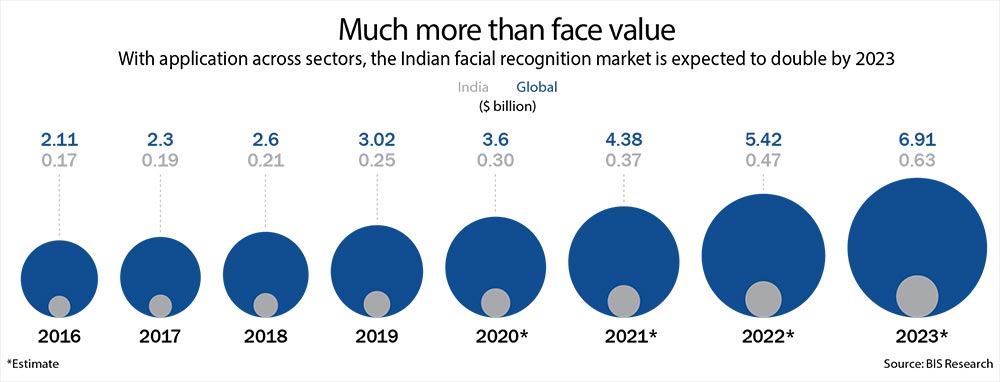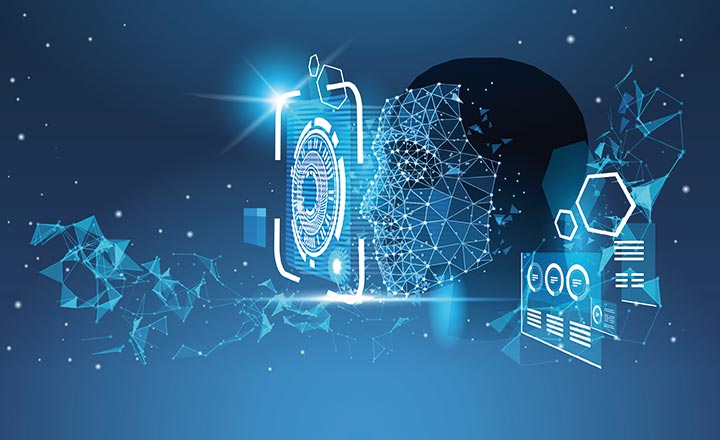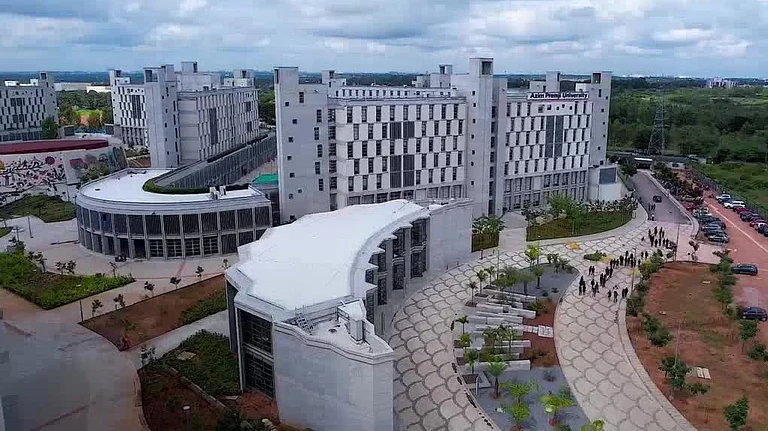God, they say, is all-knowing. S/he/it knows if you are wishing your neighbour well, or are wishing them dandruff. That said, a Brazilian church (which trusts divine intelligence) thought there’s no harm in seeking help from artificial intelligence. Therefore, it has installed facial recognition (FR) software that can tell if the faithful are feeling sad, happy or guilty, besides tracking their attendance. When God buys into a technology, you know it is formidable.

Globally, the FR market is expected to more than double — from $3.02 billion in 2019 to $6.91 billion in 2023. India’s FR market, too, may double from $251 million to $632 million, over the same period (See: Much more than face value). The technology is already widely used in India. You may not have realised it, but the bots are reading your faces in supermarkets and bus stations, and apartment elevators and even childcare centres. In fact, our country will soon implement the world’s biggest FR system, called the Automated Facial Recognition System (AFRS). It will be used, says the National Crime Records Bureau or NCRB, which conceptualised the system, to identify criminals and the dead, and locate missing people.
Of course, there are privacy concerns. “Facial recognition as a technology inspires awe and fear, at the same time. Despite the growing attention to its broad applications across industry and geography, there is still concern surrounding facial recognition’s ethical applications and privacy restrictions,” says Ashvin Vellody, partner, Deloitte India. So FR technology, as promising as it looks, has in it the good, the bad and the ugly.
The good
A large part of the FR market is geared towards security and surveillance solutions. Many start-ups, such as Gurugram-based Staqu Technologies, are already working on AFRS products. Founded in 2015, the start-up has created an app by collating data from the NCRB website. It is called Police Artificial Intelligence System (PAIS), which the state police have access to. Here’s how it works: Say a police official has nabbed a suspect in a case of chain snatching. He can take a photo of the suspect, upload it on the app and see if the person is a repeat offender. Or, the police can also run CCTV footage collected from ground zero and browse the app for category-wise offenders. “From solving a murder case in Amritsar to recovering a robbery of Rs.1.2 million in Ghaziabad, PAIS has helped in solving several cases,” says Atul Rai, co-founder and CEO, Staqu Technologies. Currently, eight states, including Punjab, UP and Rajasthan, use its solution. The company recorded revenue of Rs.200 million in FY20 and is expecting to double that in FY21.
Since CCTVs cannot be everywhere, the start-up has also created Smart Glasses, which can be worn by the police to detect known criminals during mass gatherings such as political rallies. “It costs about Rs.700,000 per piece, so we haven’t deployed it commercially yet,” says Rai. There is more up their sleeve. Their in-house developed software called Jarvis can teach Iron Man’s J.A.R.V.I.S a thing or two. First launched in UP prisons, it helps in sensing violence and gang planning. “Through the installed CCTVs, it can detect aberrations using FR and AI,” says Rai.
Bengaluru-based Camfyvision, founded in 2018, also has a similar business model. For its pilot project with the city police, the company has deployed its FacEAI-PRO at select locations such as malls and bus and railway stations for surveillance. They eventually plan to charge clients an annual subscription fee, besides for the hardware. “Our tech is more accurate for Indian faces and skin tone,” says Vedpal Singh, founder and CEO, Camfyvision. Singh, who led an AI team at Mindtree earlier, began working on the start-up, concerned about child safety at schools and pre-schools. Wherever it is deployed, FacEAI-PRO can detect and track people with algorithms and record entry/exit timings. The company expects to reach revenue of Rs.13.4 million in FY21 and is targeting FY24 revenue of Rs.163 million.
Just as safety in schools got Singh to build Camfyvision, the present pandemic caused Ramco Systems to advance their FR technology. At the software company, attendance of employees was already being registered through RamcoGEEK, an AI and FR powered system. Employees were using their facial signature, which is made by various focal points of a person’s face, to open doors in three seconds. Then COVID-19 struck and the company decided to upgrade their system. They integrated a thermal scanner with GEEK. “If the body temperature is higher than normal, then the IoT-enabled doors will not open and a message will be sent to his supervisor to take precautionary measures,” explains Ramesh Sivasubramanian, head-Ramco Innovation Lab, Singapore. The company is in talks with clients across auto, logistics, manufacturing and pharma industries to deploy this solution, he adds. RamcoGEEK can track employee movement to keep them away from restricted zones, can detect inebriation, which could be useful for transport companies and can be used offline, for areas with poor internet access. Impressive, but this is a country of jugaad, so people are likely to send a photo with an obliging colleague to register attendance. Therefore, GEEK also promises ‘liveliness detection’ — to see if the subject is alive or static, like a photo — to sniff out such frauds.
The insurance sector could do with such swindle-busters. Do you know the biggest swindle committed in the life insurance business? Insuring a dead person. The onus of verification lies with the agent, who is also sometimes hand-in-glove with the fraudsters. A liveliness test sure comes in handy then. Therefore, there is AuthBridge’s solution. Through it, the life insurance firm sends a link on the customer’s phone to download an app. The customer has to then upload a photo of his ID and follow it up with a selfie video. “We ask him/her to turn their head, move their eyelids and read a few numbers that we show on the mobile screen. Through all this, the AI figures out whether the person is alive or dead. The algorithm confirms and thereby eliminates risk or bias,” explains Ajay Trehan, founder and CEO, AuthBridge.
FR is not all morbid and stern. It has fun applications, too. Last year, fashion rental store Flyrobe introduced ‘trial rooms’ with virtual walls that allow customers to try different outfits without having to wear them. Similarly, a global cosmetics major approached IT services firm CSS Corp with a problem: they wanted to upgrade their operations to a digital platform to improve customer experience and cut costs. So, CSS Corp created an augmented-reality-powered mobile application that allowed users to get product recommendations using facial recognition. “Our tool also provides diagnostics about skin tones, wrinkles and blemishes,” says Kiran Marri, chief scientist and vice president-digital engineering, CSS Corp. It can tell you if that fluorescent pink eyeliner will be a disaster or a simple scare.
FR solutions can help retail customers, like it did with that pink eyeliner; or it can help the store, on whether to stock the eyeliner. For the latter, Camfyvision is working on a product. Picture this: You are walking down the aisle at a supermarket, scouting for organic tea. Your hand reaches out to pick your usual brand, when a newer brand catches your eye. You pick it up, read the contents, and decide to switch back to your usual brand. Scenario two: You are in a lifestyle store, browsing through the latest collection of dresses. You wrinkle your nose at asymmetrical hemlines while giving an approving look to flared pants, and finally make a purchase. In both scenarios, a CCTV camera would be analysing your reactions in real-time. “This will enable in getting granular insights regarding what goes unsaid by customers,” says Singh. Such data provides retailers with information on what to stock, where to stock and how much to stock. Singh adds that this technology can also be used by companies in hospitality and at multiplexes. The start-up has begun pilots in two supermarkets, and plans to charge Rs.6,000/month per store.
Prama Hikvision India, a company that has products for traffic management, security surveillance and attendance solutions, says that they are also working with retailers to provide VIP Recognition. VIP here refers to loyal customers. Ashish Dhakan, CEO, Prama Hikvision explains that their solution will equip retailers to identify repeat customers, track footfall and manage queues, so that staff can provide the right kind of service at the right time.
Just as retailers have to contend with competing distractions, educators have to, as well. Therefore, to help teachers, there is Miko 2. Launched two years ago, it is a personal robot that can not only teach kids math, music and games, but can also detect whether a child is engaged or distracted. “Our tech has emotional intelligence, which helps in providing personalised content based on the child’s mood,” says Prashant Iyengar, co-founder and CTO, Emotix. Sold through offline and online channels, the product is shipped to over 52 countries..
The bad
On the face of it, all of this sounds good. What is not to like about keeping a child engaged? But, how comfortable would a parent be if his/her child’s image was constantly read? Iyengar says that their proprietary tech is conscious of the privacy concern, and therefore only processes the image on the device. No data is uploaded to the cloud for data use. That said, there are anxieties around the use of FR.
Take the surveillance application, for instance. In particular, consider the tech being built for India’s gleaming new AFRS system. First, it is not fully refined. The current algorithms guarantee about 97% precision. There are concerns “like inability to match features when faces tilt, inability to recognise colours accurately, leading to demographic differentials and limitations on the available databases,” says Dr SS Mantha, former chairman of All India Council for Technical Education. So, criminal identification by FR must be supported by secondary and tertiary methods such as protocol investigation and evidence collection.
Then comes the age-old debate between customisation and privacy. We like product recommendations but not snooping into our personal use of that product (like Facebook holiday photos) and this conflict is what experts call the ‘privacy paradox’. “The risk is real and growing,” says Deloitte India’s Vellody, adding, “It is no secret that companies globally have been accumulating consumer information to improve marketing effectiveness.” Dhrubabrata Ghosh, director, data and analytics, Protiviti Member Firm for India, believes that the consumer has the power to control their data to a large extent. “It actually depends on the choice of an individual — what and how much they are willing to share, and to what extent the policy and the governance of these are defined,” he says. But is privacy that easily managed?
Last November, MediaNama editor Nikhil Pahwa had taken to Twitter to express his objection with tea cafe chain Chaayos using FR to take orders. He had pointed out that the company does not explain how the user data will be used and does not give the buyer a way to opt out of this. The website added that all of this was being done when the country did not have a sufficient privacy law and rules around FR. “This (the FR tech) is unnecessarily intrusive,” Pahwa told BBC in an interview post the incident. While Chaayos issued a clarification saying that customer data is fully encrypted, there is still worry over data leaks. Case in point Clearview AI, a face-collecting company database that was hacked in February. It had more than three billion photographs from Facebook, YouTube and Twitter. The company released a statement saying that it has “patched the flaw that allowed the breach to happen” and that the hacker did not get access to its server. Ramco System and Camfyvision provide option for retailers to store data on their local server instead of the cloud, where chances of hacking are more. AuthBridge’s Trehan says that companies can protect data by having layers of encryption or breaking data into pieces and storing it on multiple servers.
However, are the start-ups authorised to collect such data at all? This uncertainty is making investors uncomfortable. There is investor interest in these start-ups, says Hemant Gupta, managing director, Zone Startups India. That said, he adds, “Because of the sensitive nature of the technology with its implications on privacy and security, funding for these start-ups happen mostly through undisclosed deals.” Legal clarity would help tap into this developing opportunity in the post-pandemic world. Gupta, who heads the India-based accelerator, says that, in the coming months, facial recognition will be preferred over other biometric technologies due to its non-contact process, easy deployment and enhanced level of security.
The Ugly
Without legal safeguards, if the use of such tech by private companies is discomfiting, its use by governments is terrifying. Take China’s Social Credit System for example. Imagine being marked a lower ‘social credit’ score for not honouring hotel reservations or having coffee in trains, and then that score determining your credit facility. The country is also accused of using FR for racial profiling, and Israel has been accused of using it to track Palestinians in the West Bank and in Russia.
In India, the same technology that is used for the purpose of tracking missing individuals can be used for snooping and monitoring everyone. People who participate in political protests have expressed worries of being targeted, after being spied on through FR tech. Of course, police officials have denied misuse.
On the face of it, there is an attempt to empower citizens with rights relating to their personal data, through the Data Protection and Privacy Bill 2019. The bill was introduced in the Lok Sabha in December 2019. It promotes concepts such as consent framework, purpose limitation, storage limitation and data minimisation. “But, the devil is in the fine print and its interpretation within the ambit of the IT Act of 2000,” says Dr Mantha. For instance, in order to seek protection under various legislations, one must first establish that facial recognition data is ‘sensitive personal data’ under the IT Act, which is easier said than done. Under Section 43A of the same Act, commercial bodies are liable to pay compensation for negligent collection and handling of sensitive data. But, one will have to prove that such bodies do not follow “reasonable practices and procedures”, which is a vague phrase.
Perhaps, we could take lessons from the European Union and its General Data Protection Regulation (GDPR) for data protection and privacy. It gives control to individuals over their personal data. It also mandates data collectors and controllers to reveal purpose of using data, how long it is retained, who it is shared with and so on. This law was made in 2016 and implemented in 2018. Other countries, including China, Japan, Brazil and the US followed with similar regulations. So, passing the bill in India is the need of the hour, but it is currently being analysed by a Joint Parliamentary Committee to fill the gaps. Just as FR is advancing in leaps and bounds, law should, too. Otherwise, consumers may get the coffee they like to the last detail, but citizens may lose democratic rights.











